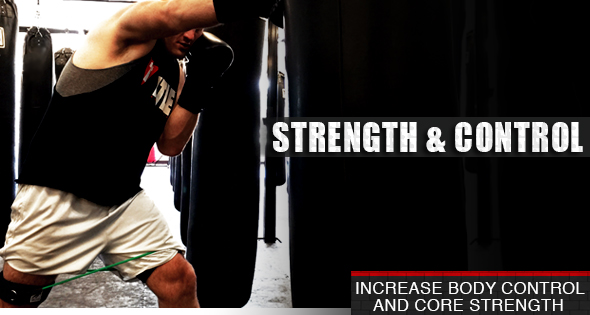Boxing Moves And Boxing Combinations With Kbands
Being able to move and throw boxing combinations will allow a boxer to develop and advance into more complex boxing moves and boxing combinations. However, like any sport an athlete must be familiar with boxing basics such as how to throw a punch or boxing combination with the entire body moving and operating as one. When athletes are able to use their rotational power, core strength, and footwork to deliver their punches the speed and power that comes along with these full body boxing combinations will be hard for an opponent to stop.
Footwork And Boxing Basics
In order to be effective at utilizing the feet and torso during boxing combinations athletes must first develop the speed, coordination, and power in the torso and lower extremities to continually produce quick, strong, quality punches which make up boxing combinations. Getting back to boxing basics is the key to develop great punches and boxing combinations. Developing great footwork with two simple punches like the jab and cross will allow athletes to focus on how to use their feet ,hips, and torso effectively when throwing punches. After athletes have mastered the footwork and technique with these boxing moves they can move into mastering more difficult boxing punches like the upper cut and hook and beginning to work these punches into new boxing combinations.
Performing boxing moves and boxing combinations in the same manner as they would be performed in a competitive match will be helpful in developing boxing basics and proper movements for the athlete. Athletes who can perform different boxing combinations while moving down a line of boxing bags, sparring with a partner, or circling around a boxing bag are all great ways to simulate movement during a boxing match and will give athletes the experience of throwing quick, repetitive boxing combinations at a moving target.
Furthermore, adding the dual action effects of the Kbands Leg Resistance Bands allows the athletes to strengthen the muscles which make up the thighs and hip flexors. By strategically placing the resistance at the bottom of the quadricep (close to the knees) muscles the Kbands Leg Resistance Bands place a larger amount of resistance on these muscles as they move through linear, lateral, and rotational movements. Using the Kbands Leg Resistance Bands while performing boxing moves and boxing combinations will allow athletes to simultaneously develop the proper movements, strength, and power when throwing boxing combinations or boxing moves.
Athletes are encouraged to use the Kbands Leg Resistance Bands during all of their boxing training as developing strength and power in the legs can easily be achieved by practicing boxing basics such as defensive drills, boxing combinations, footwork drills, and even core strengthening exercises. Athletes can also go to the Training Section to learn how to apply the use of Kbands Leg Resistance Bands to hep improve other, non sports specific, athletic skill sets.
Kbands Boxing Basics
The Kbands Boxing Basics Drill is a fantastic boxing moves drill which utilizes the Kbands Leg Resistance Bands and incorporates the movements and tempo of a high intensity boxing match. To begin the Kbands Boxing Basics Drill athletes will need to securely attach a set of Kbands Leg Resistance Bands just above their knees. The amount of resistance used during the Kbands Boxing Basics Drill should reflect the skill and strength level of the athlete, as well as their familiarity with the Kbands Leg Resistance Bands. Athletes who are younger and less experienced with boxing moves, and or the Kbands Leg Resistance Bands, should begin the Kbands Boxing Basics Drill using the Red Level of Resistance Bands. Older athletes who are move experienced with boxing moves or are more familiar with using the Kbands Leg Resistance Bands should advance to the Green Level of Resistance Bands. Once athletes have mastered the Kbands Boxing Basics Drill with Green Level Resistance Bands they can advance to the Blue Level Resistance Bands.
After athletes have securely attached the Kbands Leg Resistance Bands above their knees they will put on a pair of boxing gloves and line up at the end of a line of 6-8 boxing bags. Athletes will begin at the first bag by throwing a boxing combination consisting of a cross, jab, jab, jab, cross. The two cross punches should be powerful and strong whereas the jabs should be quick and should slightly change level. Changing levels with the jabs will allow athletes to simulate an opponent ducking and dodging the punches. Beginning and ending with a strong cross punch will allow athletes to simulate a strong start and finish to their boxing combinations.
Athletes will move down the line of boxing bags throwing the same combination, taking a few moments after each of the boxing combinations to reset and reposition the feet and upper body. Athletes should practice moving both directions down the line of boxing bags to simulate moving and throwing boxing combinations from both directions. The combination described above is recommended for athletes to begin performing the Kbands Boxing Basics with, however, as athletes advance in their training and master the boxing basics they can advance to using different, more complex boxing combinations.
Athletes should perform the Kbands Boxing Basics 3-4 times from each direction before removing the Kbands Leg Resistance Bands and performing 1-2 unresisted rounds of the Kbands Boxing Basics Drill.
Help Your Body Recover From Boxing Training
Flexibility exercises, active stretching, and the Recovery Foam Roller are all great tools athletes can use before or after their boxing training. Although active stretching is exclusively reserved as a pre workout warm up flexibility exercises and the Recovery Foam Roller can be effective when used both before and after boxing training sessions. Flexibility exercises allow the muscle to lengthen helping to increase range of motion in limbs and joints. Using the Recovery Foam Roller on sore body parts allows the tightened muscles to be released while increasing blood flow to the injured or sore areas of the body.

